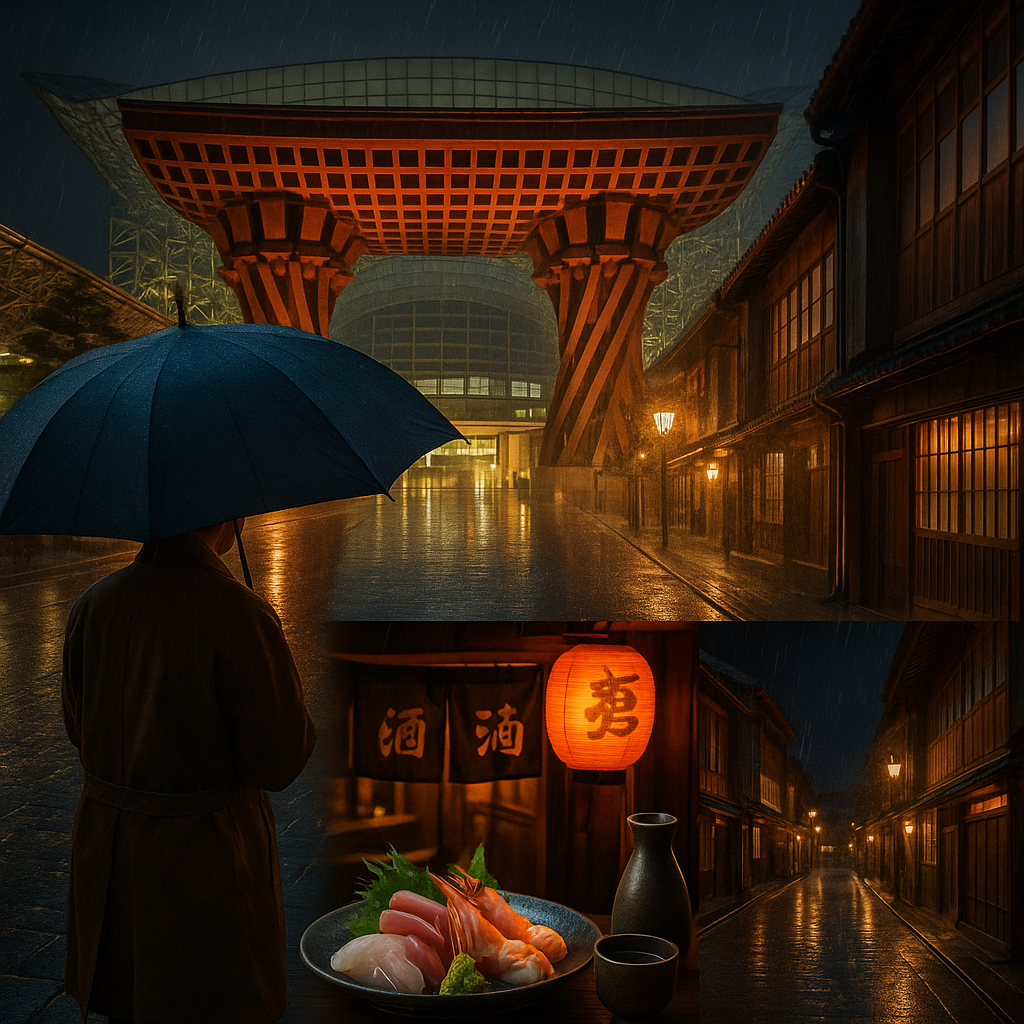Hello, this is Tom.
This time, I took a one-night, two-day trip to Kanazawa, Ishikawa—a city that came to mind when I asked myself, “What city looks beautiful in the rain?”
Often called the “Little Kyoto of Hokuriku,” Kanazawa is rich in history, cuisine, and above all, an unmistakably refined atmosphere.
Let me take you through this moody, flavorful journey that began at Kanazawa Station on a rainy night.
A Glowing Gate Under the Night Sky
I arrived in Kanazawa just past 8 PM.
After about three hours on the bullet train from Tokyo, I exited the station and was immediately met by the sight of the massive Tsuzumi-mon Gate, the city’s iconic landmark.
Its deep red columns were glowing under the lights—resembling something out of a fantasy world. The gate, modeled after a tsuzumi drum used in Noh theater, blends dignity and artistry in a way that instantly sets the tone for the city.
Next to it is the Motenashi Dome, a glass-roofed welcome hall designed to protect travelers from the city’s frequent rain.
I took a deep breath outside the station, the wet cobblestones reflecting neon lights, setting the perfect mood for this misty adventure.
First Stop: Local Flavors at Izakaya “Sen”
After dropping off my luggage at the hotel, I set off to explore Kanazawa’s culinary scene.
On the first night, I visited two izakayas near Kanazawa Station. The first was Izakaya Sen, a favorite among locals.
The meal started with a simple appetizer of seaweed in vinegar—a bright, salty bite of the Japan Sea.
Next came a three-kind sashimi sampler: cold yellowtail, sweet shrimp, and medium-fatty tuna. Each piece melted in my mouth, fresh and rich with the essence of the sea.
Then came the highlight: grilled Noto chicken tsukune with crunchy cartilage.
Golden on the outside, juicy on the inside—it was the kind of dish that demands a sip of beer after every bite.
Speaking of beer, I tried the Kaga Bocha Stout, a local craft beer brewed with roasted tea from Ishikawa. The result? A warm, toasty aroma and subtle sweetness that made it feel like a beer and dessert in one.
To finish, I had a glass of Tedori-gawa Yamahai Junmai sake—a full-bodied, umami-rich brew that paired beautifully with both the sashimi and the grilled dishes.
By then, I was completely relaxed and fully immersed in Kanazawa’s night.
Second Stop: Izakaya “Tsukumo” and Kanazawa Oden
Still riding the wave of good food and drink, I headed to Izakaya Tsukumo, the second stop of the night.
The interior was cozy and wooden, filled with the murmur of locals enjoying their own quiet evenings.
Here, I ordered Kanazawa oden—a regional take on the Japanese stew, filled with luxurious ingredients like Gensuke daikon radish, wheat gluten cakes, and even blowfish milt.
On this night, I chose fish cakes, red kamaboko, daikon, and sea snails.
The standout dish, however, was the duck simmered in sweet soy sauce, called Kamo Jiro-ni. The rich flavor of the sauce brought out the tenderness of the duck in the most comforting way.
With it, I sipped Tengumai “Ten”, a sake brewed using the yamahai method. Its complex layers of acidity and umami gave it a bold, satisfying finish.
Kanazawa’s night was deep and quiet—and I didn’t want it to end.
Morning Meal at the Kanazawa Port Fish Market
The next morning, I woke up early and headed to the Kanazawa Port Iki-Iki Fish Market by taxi.
This market isn’t a tourist trap—it’s where locals do their daily seafood shopping.
Among the vibrant offerings, the red snow crab and sea bream caught my eye.
Red snow crab is known for its sweetness and delicate meat and is often called Kobako crab when served in winter. Thanks to modern freezing techniques, it’s now available year-round.
I bought both, then headed to the eat-in space, where for just 300 yen, they’ll cook or prepare your seafood to order.
It takes about 30 minutes, so I watched the fishmongers work while I waited.
The sashimi sea bream was translucent and sweet, while the steamed crab required a bit of work to eat—but each bite was worth it. I found myself eating in total silence, totally focused.
That peaceful, flavorful morning was pure bliss.
A Rainy Afternoon in the Higashi Chaya District
By afternoon, the rain had returned—but in Kanazawa, that’s not a bad thing.
The rain-soaked stone streets, the sound of dripping eaves—it all added to the charm of the Higashi Chaya District, a beautifully preserved area of traditional tea houses.
Though it was bustling with tourists, a short walk into the alleys revealed a stillness broken only by rain and the scent of old wood.
My goal here was to explore traditional Kanazawa seasonings.
Shops in the district offer aged miso, artisan soy sauces, and the famous Ishiru—a type of fish sauce made by fermenting salted fish, used heavily in Noto’s cuisine. Think of it as Japan’s answer to Southeast Asian fish sauce.
I sampled Kaga miso, known for its deep richness, and a sweet, dark soy sauce unique to Ishikawa.
The shopkeeper grinned and said, “Just pour it over rice—you don’t need anything else.”
He was right. I knew I’d be taking a bottle home in my suitcase.
Ending on a Misty Note
And just like that, my one-night journey through Kanazawa came to an end.
Yes, sunny days are wonderful—but in Kanazawa, it’s the moisture in the air that brings the city to life.
The quiet chatter of izakayas, the silence of the morning fish market, the soft sound of your own footsteps on wet stone.
There’s something unforgettable in every corner—not just in the food, but in the people, the history, and the atmosphere.
Next time, I’d love to walk through Kenrokuen Garden under a clear sky.
But for now, I left Kanazawa with the soft rain bidding me farewell.
Thanks for reading, and see you on the next trip!


